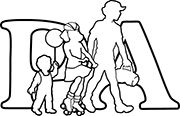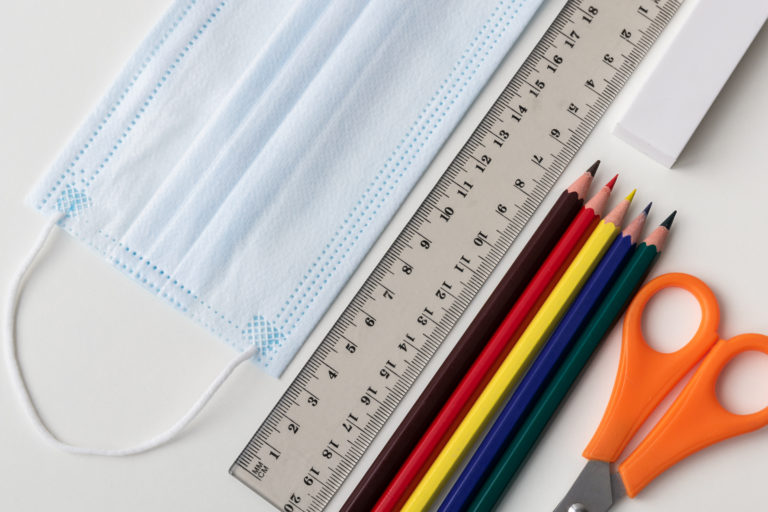Educational Settings & COVID-19: Commonly Asked Questions
Am I going to get COVID-19 by teaching in the classroom?
Research has shown that teachers and staff do not have significantly increased risks compared to other occupations. In schools, the biggest risk is adult-to-adult spread when mitigation is not being followed, such as eating/meeting close together without masks. Reassuringly, CDC data (as of 1/13/21) shows that cases of COVID-19 in communities where K-12 schools offer in-person education (401.2 per 100,000) were similar to that in counties offering only virtual/online education (418.2 per 100,000).
What kind of mask should I wear?
A snug fit, with a tight weave of material, with no external valve is best. N95s are not needed. Double masking can provide additional protection if desired. Face shields do not serve as a substitute for a face mask.
Should teachers wear goggles?
Goggles are not necessary unless working in special circumstances.
I am always moving around the classroom. How will I know if I have had a close contact?
The VDH/CDC define “close contact” as being within 6 ft of someone who has COVID-19 for 15 minutes or more, and you should be notified by contact tracers if you fit that criteria. If you move from school to school, talk to your supervisor to find a way to keep track of close contacts. It may be reassuring to know that some parts of the country and some healthcare systems have removed quarantine requirements if everyone was masked, because they have seen that school/healthcare spread is very low.
A child in my classroom has COVID-19. Am I going to get it? Will my students?
In schools that have been open, when a child is infected and proper mitigation is practiced (especially masking), the vast majority (if not all) of the children and adults in the classroom have remained unaffected. For example, in Ohio, researchers found that coronavirus cases in students quarantined due to exposure was about the same as those farther away or outside the classroom but in the same grade. For this reason, Ohio (along with OK, IN, UT, MI) is no longer quarantining students who were exposed to the coronavirus in the classroom as long as they were wearing masks.
My students have a hard time physically distancing. Are they more likely to get COVID-19?
Fortunately children (especially <10) do not spread or catch COVID as well as adults. Encouragingly, a recent large-scale multicenter study with 4964 participants demonstrated that children (10 and under) had a 3-fold lower level of antibodies (0.6%) compared to adults (1.8%); this is one study of many that indicate young children do not spread the virus as effectively as adults. Proper masking is more important than perfect physical distancing. Hand hygiene is also beneficial.
My students love physical contact. How much should I prevent students from touching each other? What if a student hugs me?
‘Close contact’ involves being in close proximity for an extended period of time, and risk can be minimized dramatically with mask-wearing and hand washing. Brief physical contact throughout the day is very unlikely to result in transmission.
Should I be touching desks, papers and supplies that other children have touched?
Risk of getting COVID from touching objects is exceedingly rare, compared to what we initially thought. In fact, as of November 1, 2020, there have only been three cases reported worldwide on possible transmission from objects and surfaces, like doorknobs, countertops, keyboards, toys, etc. Even though the virus can sometimes be detected on materials, almost always the virus is not viable (alive) and therefore cannot cause COVID-19. As experts at Duke have stated, “coronaviruses can survive on surfaces; however, this does not equal transmission of infection.” Furthermore, an individual would have to touch a largely infected surface and immediately afterwards touch their eyes, mouth or nose for transmission to even be possible. Since the virus can survive on skin for short periods of time, routine hand washing/ sanitizing and avoiding touching your face and/or mask should dramatically decrease risk of surface transmission.
Can kids use school playgrounds?
The AAP states “outdoor playgrounds/natural play areas only need routine maintenance, and hand hygiene should be emphasized before and after use of these spaces.” Wearing masks and washing hands after playground use is recommended. In a study in Massachusetts, COVID-19 was detectable on 29/348 (8.8%) of high-touch surfaces (crosswalk buttons, trash can lids and door handles); however, the amount present was below thresholds to cause disease, predicting the risk of infection from the high touch surface to be less than 0.0005%. While we are still learning about surface transmission, data to date indicate that playgrounds outdoors are low-risk if other mitigation is being followed.
I’ve heard some variants are ‘much more contagious.’ What does that mean for our safety in schools?
Schools can stay safe using the same mitigation techniques (masking/etc). In reality, the change of infectiousness is not a dramatic increase to an individual when s/he is working in a mitigated environment.
What about kids spreading it to each other without anyone knowing?
Studies to date indicate that this is NOT the case, as rates in schools are lower or equal to that in the community. It is encouraging that data from 191 countries from a 7-month period (2/10/2020-9/29/2020) showed no consistent association between school reopening status and COVID-19 infection rates.
My school has had a lot of cases listed on the dashboard. How do I know it’s safe to be there?
When kids come into the school with COVID-19, it is considered a “case.” However, if the child does not give it to anyone else, there is no transmission. In fact, because schools are controlled environments in which mitigation is practiced, transmission is unlikely to occur in schools compared to other places in the community (bars, gyms, households). Additionally, we can more easily monitor transmission within schools. For instance, in North Carolina, a large study with over 100,000 students and staff during times of high community rates of COVID-19 reassuringly had only 32 within-school transmissions, in which the majority were related to absent face coverings. There were also no cases of child-to-adult transmission. If spread was as common in schools as it was in the community, one would anticipate 800+ secondary infections, however, there were only 32 cases. Also, a Wisconsin study found that the COVID 19 cases among students and staff members was 37% lower than in the surrounding county even in the setting of widespread community transmission (up to 40% test positivity), with very limited spread among children within their cohorts and no documented transmission to or from staff members.
What can I do outside of the school setting to help prevent cases of COVID-19?
It is more likely adults will get COVID-19 from friends, family or the community as opposed to within an educational setting. For instance, a large study of over 38,000 in-person students and staff in South Carolina schools (over a two month period in the fall 2020) resulted in 500 positive cases, the majority of which were out-of-school transmission. Mitigation should be practiced out of school also.
Do I need to buy a HEPA filter for my classroom?
This is not needed. The school should work with you if you have questions about air flow in your classroom as the CDC/VDH has much on air filtration/HVAC settings for buildings.
Should I get vaccinated? Will it help?
The Moderna/Pfizer vaccines are 94-95% effective at preventing symptomatic laboratory-confirmed COVID-19 illness in people who receive two doses. Preliminary data suggests the vaccines afford some protection even after a single dose.
I live with an elderly parent. I’m scared to bring COVID-19 home to him/her.
Studies to date have shown that teachers are not at higher risk of acquiring COVID-19 at work than individuals in most other occupations, such as healthcare and the service industry.

